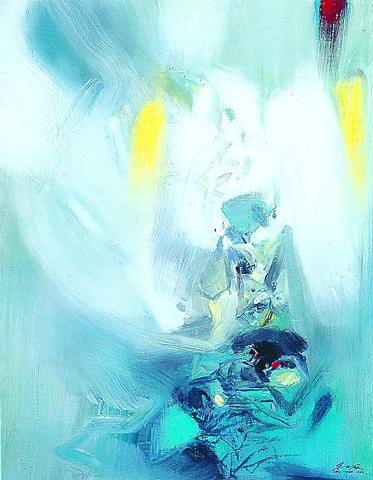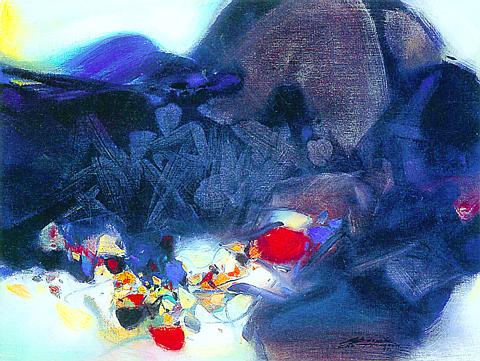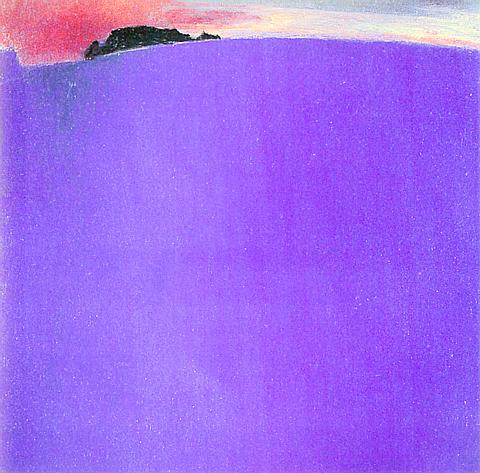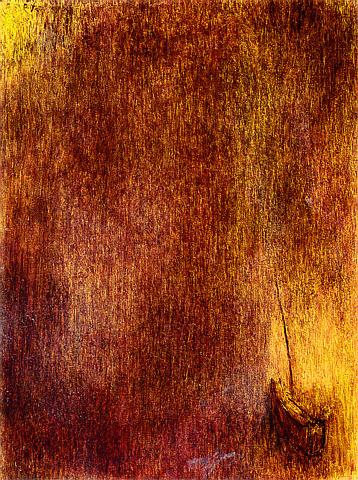There is a strong sense of rarity to this show, a feeling that it won't ever happen again.
Three legendary figures from the Taiwanese art world, all in their 80s -- men that had their heyday in the 60s and 70s yet whose prestige has stretched into the new millennium -- have been brought together in a group show.
Wang Pan-yuan (

The 30 pieces on view at the gallery all date from a period 30 years ago. During the 60s, Zao and Chu stepped into abstract painting and the years that followed shortly after represent the peak of their careers and the beginning of Wang's. The works from this period are also more valuable than the artists' recent works.
The 89-year-old Wang doesn't like to sell his works so they don't pop up on the market very often. According to Richard Chang, owner of Galerie Grand Siecle, it took a while for him to persuade Wang to join the show, and even when he acquiesced, it was only out of his respect for the other artists.
Wang's style is minimal, sober and ethereal. There's a sense of perseverance in the layers of quiet colors which reflect the strength of the artist and his determination to withstand the vicissitudes of life. Viewers are enticed into lingering around his paintings, admiring the beauty of desolation which they convey.

Wang is a bit of a cult figure in Taiwan, especially in Yilan, where his secluded lifestyle stirs up enough mystery to make him a name known in many households. His large, old -- and expensive -- works are a rarity to exhibitions, yet the doyen of the Taiwan arts world is willing to give them away. For example, at one time the Yilan Cultural Center wanted to purchase some pieces but Wang insisted on donating them and then asked the center to buy the works of young artists instead.
For this exhibit, the gallery owner particularly recommends the piece titled Kuishan Tao (
The 80-year-old Chu left Taiwan in 1955 for France, where he became a highly reputed artist, holding more than 200 exhibitions during the next 40 years. It was a career of creativity that, among other things, earned him an honorary membership last year in Academia Francais, a multi-disciplinary think-tank similar to Taiwan's Academia Sinica. Chu's excellent use of coloration has prompted his peers and critics to dub him "the magician of colors." Indeed, looking at his paintings is sometimes like peeping through a kaleidoscope -- the colors surge and flow like a piece of orchestra music, full of a passion for life.

The artist combines the techniques of Western and Chinese paintings. He uses Chinese calligraphy and ink but the lines are bold and flowing, heavily influenced by Western abstract paintings.
Zao has gained international renown, a true master who is able to mix feelings of both unsettlement and ease in his paintings. A high-profile figure, he is regarded by many as the first Chinese to gain international acclaim as a painter. Chang says Zao puts out 12 paintings per year which are bought by European collectors in countries such as Spain, Switzerland and France.
Compared to Chu's abstract paintings, Zao's paintings are far more subtle in their presentation of lines and dots, conveying the temperament of classical Asia. There is an abundant poetic ambience in his works that critics have interpreted as conveying feelings of freedom and suspension. Paul Klee and Cezanne are two European artists that have influenced how Zao developed his style.

Most of Chu's works seen in Taiwan are his more recent ones. His early works, such as those displayed at the gallery, are mostly in the hands of European collectors, who have loaned them to this exhibit.
Although the general public is invited to the show, the gallery is trying to target collectors with a keen interest in these masters and deep pockets. Prices for the paintings on exhibit start at NT$200,000.

Behind a car repair business on a nondescript Thai street are the cherished pets of a rising TikTok animal influencer: two lions and a 200-kilogram lion-tiger hybrid called “Big George.” Lion ownership is legal in Thailand, and Tharnuwarht Plengkemratch is an enthusiastic advocate, posting updates on his feline companions to nearly three million followers. “They’re playful and affectionate, just like dogs or cats,” he said from inside their cage complex at his home in the northern city of Chiang Mai. Thailand’s captive lion population has exploded in recent years, with nearly 500 registered in zoos, breeding farms, petting cafes and homes. Experts warn the

No one saw it coming. Everyone — including the Chinese Nationalist Party (KMT) — expected at least some of the recall campaigns against 24 of its lawmakers and Hsinchu Mayor Ann Kao (高虹安) to succeed. Underground gamblers reportedly expected between five and eight lawmakers to lose their jobs. All of this analysis made sense, but contained a fatal flaw. The record of the recall campaigns, the collapse of the KMT-led recalls, and polling data all pointed to enthusiastic high turnout in support of the recall campaigns, and that those against the recalls were unenthusiastic and far less likely to vote. That

The unexpected collapse of the recall campaigns is being viewed through many lenses, most of them skewed and self-absorbed. The international media unsurprisingly focuses on what they perceive as the message that Taiwanese voters were sending in the failure of the mass recall, especially to China, the US and to friendly Western nations. This made some sense prior to early last month. One of the main arguments used by recall campaigners for recalling Chinese Nationalist Party (KMT) lawmakers was that they were too pro-China, and by extension not to be trusted with defending the nation. Also by extension, that argument could be

Aug. 4 to Aug. 10 When Coca-Cola finally pushed its way into Taiwan’s market in 1968, it allegedly vowed to wipe out its major domestic rival Hey Song within five years. But Hey Song, which began as a manual operation in a family cow shed in 1925, had proven its resilience, surviving numerous setbacks — including the loss of autonomy and nearly all its assets due to the Japanese colonial government’s wartime economic policy. By the 1960s, Hey Song had risen to the top of Taiwan’s beverage industry. This success was driven not only by president Chang Wen-chi’s